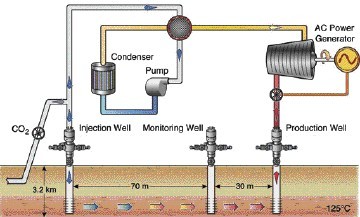
CO2 is now a major headache and headlines are full of stories about how to capture and store the gas. Carbon capture is considered by UK policymakers to be the way ahead.
But a group of scientists in California have different ideas and their work is being funded by the US Department of Energy.
About a year from now, two shipping containers will be installed in a field in Cranfield, Mississippi.
They will house turbines designed to generate electricity in a way that’s never been done before. If initial tests go well, the technology could lead to a new source of clean, domestic energy and a new way to fight climate change.
A team led by Lawrence Berkeley National Laboratory (Berkeley Lab) scientists hopes to become the first in the world to produce electricity from the Earth’s heat using CO2. They also want to permanently store some of the gas underground.
The group received $5million from the US Department of Energy earlier this summer to design and test the technology.
This is the first project intended to convert geothermally-heated CO2 into useful electricity, according to Barry Freifeld, a mechanical engineer in Berkeley Lab’s Earth Sciences Division who leads the initiative.
The idea is to inject carbon dioxide 3km underground into a sedimentary layer that’s 125C. Carbon dioxide enters a supercritical state under these conditions, meaning it has both liquid and gas properties.
The gas will then be pulled to the surface and fed into a turbine that converts heat into electricity.
Next, it will loop back underground and through the cycle again. Over time, some will be permanently trapped in porous rock. More CO2 will be continuously added to the system to keep the turbines spinning.
The Berkeley team thinks this technology could help offset the cost of geologic carbon storage, a promising climate change mitigation strategy that involves capturing CO2 from large stationary sources like power stations and pumping it deep underground.
This enables the burning of fossil fuels without releasing the greenhouse gas into the atmosphere. But it’s costly and is the approach planned in Scotland.
“Carbon storage takes a lot of power – large pumps and compressors are needed. We may be able to bring down its costs by generating electricity on the side,” says Mr Freifeld.
It also offers a new way to tap geothermal energy. For more than a decade, scientists at Berkeley Lab and elsewhere have theorised that supercritical CO2 can be used instead of water. Their work has shown that supercritical CO2 is better than water at mining heat from the subsurface. But no one has tried to do it until now.
In the project’s first stage, Ohio-based Echogen Power Systems will de sign a turbine that can handle “dirty” supercritical CO2 laden with hydrocarbons and water accrued during its subsurface journey. University of Texas scientists will analyse the environmental impacts of the process over its entire life span.
Berkeley Lab scientists will use numerical models to predict how the reservoir will evolve over time as more and more carbon dioxide courses through it. They’ll also determine how much energy can be extracted from the gas by coupling reservoir models with Echogen’s turbine.
In the second stage, the team will build and test the turbine. If that goes well, they’ll operate it during a pilot test at the Southeast Regional Carbon Sequestration Partnership’s Cranfield site, where a US Department of Energy-funded CO2 injection project has been under way since 2009.
The site’s 3km-deep reservoir has proven ideal for carbon sequestration. Much of the infrastructure needed for the test is already in place, including injection and production wells. The CO2 will come from a pipeline operated by Denbury Resources.
The technology takes advantage of a problem common to conventional geothermal energy. Some 5-10% of the water injected in these systems is “lost” as it travels through the pore spaces. As this happens, more water must be added, perhaps from municipal sources that have little to spare.
“But we actually want some of the carbon dioxide to become trapped,” says Mr Freifeld.
“Our approach relies on this gradual loss as a way to store a power plant’s carbon dioxid e underground rather than emitting it into the atmosphere.
“Our planned demonstration is the first attempt at proving that we can simultaneously mitigate greenhouse gas induced climate change and generate clean base-load power using geothermal energy.”
Recommended for you
